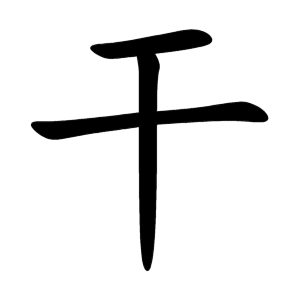Pinyin: Gwoyeu Romatzyh: gan Cantonese Yale: gōn | Bopomofo: ㄍㄢ Wade–Giles: kan Jyutping: gon1 | |
 | ||
Radical 51 (干 Unicode U+5E72, pinyin gān meaning "oppose" or "dried") is one of 31 out of the total 214 Kangxi radicals written with three strokes.
Contents
There are only nine characters derived from this radical, and some modern dictionaries have discontinued its use as a section header. In such characters that are derived from it, it mostly takes a purely phonetic role, as in 肝 "liver".
In origin, the character depicts a kind of fork used as weapon used in hunting or in warfare, or alternatively either a pestle or a shield. It can be traced to the seal script.
In simplified Chinese
As a character (not a radical), 干 has risen to new importance, and even notoriety due to the 20th-century Chinese writing reform. In simplified Chinese, 干 takes the place of a number of other characters with the phonetic value gān or gàn, e.g. of 乾 "dry" or 幹 "trunk, body", so that 干 may today take a wide variety of meanings.
The high frequency and polysemy of the character poses a serious problem for Chinese translation software. The word 幹 gàn "tree trunk; to do" (rarely also "human body"), rendered as 干 in simplified Chinese, acquired the meaning of "to fuck" in Chinese slang. Notoriously, the 2002 edition of the widespread Jinshan Ciba Chinese-to-English dictionary for the Jinshan Kuaiyi translation software rendered every occurrence of 干 as "fuck", resulting in a large number of signs with irritating English translations throughout China, often mistranslating 乾 gān "dried" as in 干果 "dried fruit" in supermarkets as "fuck the fruits" or similar.
